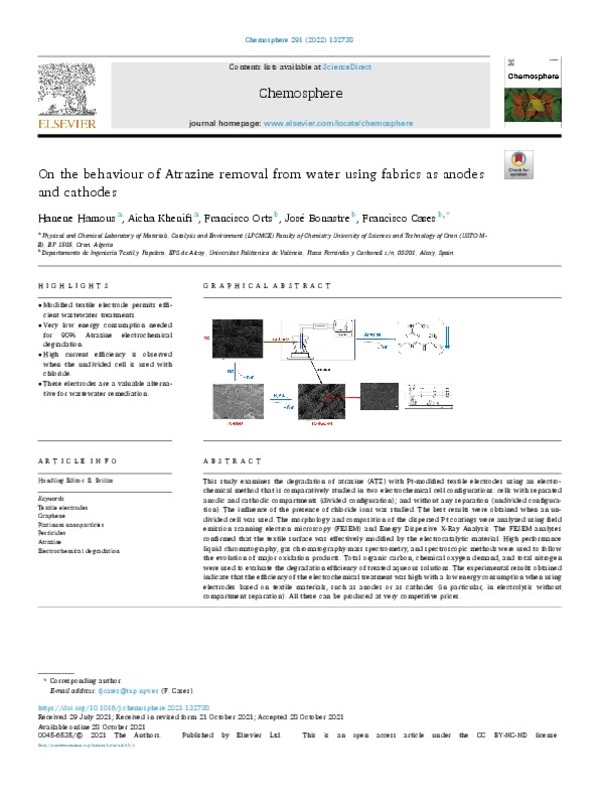JavaScript is disabled for your browser. Some features of this site may not work without it.
Buscar en RiuNet
Listar
Mi cuenta
Estadísticas
Ayuda RiuNet
Admin. UPV
On the behaviour of Atrazine removal from water using fabrics as anodes and Cathodes
Mostrar el registro sencillo del ítem
Ficheros en el ítem
| dc.contributor.author | Hamous, Hanene
|
es_ES |
| dc.contributor.author | Khenifi, Aicha
|
es_ES |
| dc.contributor.author | Orts Maiques, Francisco José
|
es_ES |
| dc.contributor.author | Bonastre Cano, José Antonio
|
es_ES |
| dc.contributor.author | Cases, Francisco
|
es_ES |
| dc.date.accessioned | 2022-01-17T19:26:57Z | |
| dc.date.available | 2022-01-17T19:26:57Z | |
| dc.date.issued | 2022-03 | es_ES |
| dc.identifier.issn | 0045-6535 | es_ES |
| dc.identifier.uri | http://hdl.handle.net/10251/179751 | |
| dc.description.abstract | [EN] This study examines the degradation of atrazine (ATZ) with Pt-modified textile electrodes using an electrochemical method that is comparatively studied in two electrochemical cell configurations: cells with separated anodic and cathodic compartments (divided configuration); and without any separation (undivided configuration). The influence of the presence of chloride ions was studied. The best results were obtained when an undivided cell was used. The morphology and composition of the dispersed Pt coatings were analyzed using field emission scanning electron microscopy (FESEM) and Energy Dispersive X-Ray Analysis. The FESEM analyses confirmed that the textile surface was effectively modified by the electrocatalytic material. High performance liquid chromatography, gas chromatography mass spectrometry, and spectroscopic methods were used to follow the evolution of major oxidation products. Total organic carbon, chemical oxygen demand, and total nitrogen were used to evaluate the degradation efficiency of treated aqueous solutions. The experimental results obtained indicate that the efficiency of the electrochemical treatment was high with a low energy consumption when using electrodes based on textile materials, such as anodes or as cathodes (in particular, in electrolysis without compartment separation). All these can be produced at very competitive prices | es_ES |
| dc.description.sponsorship | Spanish Agencia Estatal de Investigacion (AEI) and European Union (FEDER funds) are acknowledged for the financial support (contracts MAT 2016-77742-C2-1-P and CTQ 2017-90659-RED). Chemviron Carbon who kindly donated the FlexzorbTM FM10 activated carbon fabrics and Funding for open access charge, CRUE-Universitat Politècnica de València, are acknowledged too | es_ES |
| dc.language | Inglés | es_ES |
| dc.publisher | Elsevier | es_ES |
| dc.relation.ispartof | Chemosphere | es_ES |
| dc.rights | Reconocimiento - No comercial - Sin obra derivada (by-nc-nd) | es_ES |
| dc.subject | Textile electrodes | es_ES |
| dc.subject | Graphene | es_ES |
| dc.subject | Platinum nanoparticles | es_ES |
| dc.subject | Pesticides | es_ES |
| dc.subject | Atrazine | es_ES |
| dc.subject | Electrochemical degradation | es_ES |
| dc.subject.classification | INGENIERIA TEXTIL Y PAPELERA | es_ES |
| dc.subject.classification | QUIMICA FISICA | es_ES |
| dc.title | On the behaviour of Atrazine removal from water using fabrics as anodes and Cathodes | es_ES |
| dc.type | Artículo | es_ES |
| dc.identifier.doi | 10.1016/j.chemosphere.2021.132738 | es_ES |
| dc.relation.projectID | info:eu-repo/grantAgreement/Agencia Estatal de Investigación//CTQ2017-90659-REDT//APLICACIONES MEDIOAMBIENTALES Y ENERGETICAS DE LA TECNOLOGIA ELECTROQUIMICA/ | es_ES |
| dc.relation.projectID | info:eu-repo/grantAgreement/AEI//MAT2016-77742-C2-1-P//DESARROLLO DE MATERIALES POROSOS 2D Y 3D CON APLICACIONES ELECTROQUIMICAS, CATALITICAS, TERMICAS Y BIOMEDICAS/ | es_ES |
| dc.rights.accessRights | Abierto | es_ES |
| dc.contributor.affiliation | Universitat Politècnica de València. Departamento de Ingeniería Textil y Papelera - Departament d'Enginyeria Tèxtil i Paperera | es_ES |
| dc.description.bibliographicCitation | Hamous, H.; Khenifi, A.; Orts Maiques, FJ.; Bonastre Cano, JA.; Cases, F. (2022). On the behaviour of Atrazine removal from water using fabrics as anodes and Cathodes. Chemosphere. 291(Part 1):1-8. https://doi.org/10.1016/j.chemosphere.2021.132738 | es_ES |
| dc.description.accrualMethod | S | es_ES |
| dc.relation.publisherversion | https://doi.org/10.1016/j.chemosphere.2021.132738 | es_ES |
| dc.description.upvformatpinicio | 1 | es_ES |
| dc.description.upvformatpfin | 8 | es_ES |
| dc.type.version | info:eu-repo/semantics/publishedVersion | es_ES |
| dc.description.volume | 291 | es_ES |
| dc.description.issue | Part 1 | es_ES |
| dc.identifier.pmid | 34743793 | es_ES |
| dc.relation.pasarela | S\449469 | es_ES |
| dc.contributor.funder | Universitat Politècnica de València | es_ES |
| dc.contributor.funder | Agencia Estatal de Investigación | es_ES |
| dc.subject.ods | 06.- Garantizar la disponibilidad y la gestión sostenible del agua y el saneamiento para todos | es_ES |








